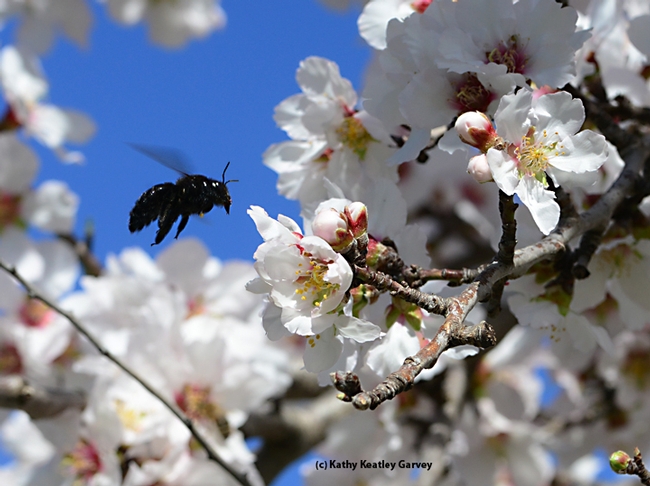We're accustomed to seeing honey bees pollinating the almonds.
But carpenter bees do, too.
We spotted a female Valley carpenter bee, Xylocopa varipuncta, foraging in an almond tree on Feb. 24 in a field adjacent to the Harry H. Laidlaw Jr. Honey Bee Research Facility on Bee Biology Road, University of California, Davis.
Sounding like a Boeing 747 Jumbo Jet, this lone carpenter bee buzzed loudly as she visited one blossom after another. She was on a mission: a do-not-linger, do-not-stop-me, and get-out-of-my-way mission.
The Valley carpenter bees, about the size of bumble bees, are the largest carpenter bees in California. The girls are solid black, while the boys are blond with green eyes. We can't count how many times people think the males are "golden bumble bees."
It's rare to get an image of "a blond and a brunette" (male and female) in the same photo. Gary Park, a contributor to BugGuide.net, did just that. Check out his amazing photos of a pair mating.
Carpenter bees derive their name from drilling holes in untreated, unfinished wood to make their nests. Only the females excavate the wood. Contrary to popular opinion, they do not eat the wood. To prevent these bees from nesting in your fence posts or deck, just paint or varnish the wood. We know some folks who like having them around and leave wood untreated and unfinished.
First and foremost, however, carpenter bees are pollinators. Excellent pollinators.
Native pollinator specialist Robbin Thorp, emeritus professor entomology at UC Davis, tries to convince people to live with these bees as “they are important pollinators in our environment and have potential as pollinators of some crops.”?
Attached Images:

A female Valley carpenter bee buzzes in the almond blossoms. (Photo by Kathy Keatley Garvey)

Full speed ahead: carpenter bee sights an almond blossom. (Photo by Kathy Keatley Garvey)

Female Valley carpenter bee meets almonds blossom. She's shaking her thoracic muscles to loosen the pollen. (Photo by Kathy Keatley Garvey)